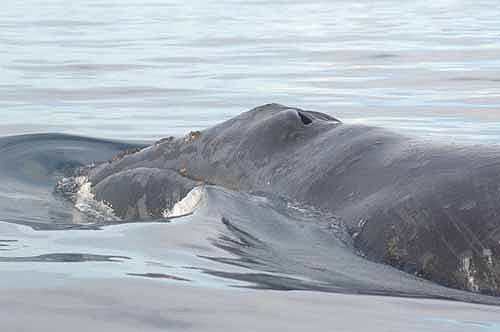 September 14, 2004
 This is one of two whales on which satellite tags were deployed. Photo credit John Durban, NMML
The scientists were working on the charter vessel Alaska Enterprise in August when they discovered the whales. The 'box' is an area in the eastern Bering Sea where North Pacific right whales are known to gather in the summer. Acoustics researchers Allan Sauter and Lisa Munger (Scripps Institution of Oceanography) deployed a sonobuoy (underwater listening device) at noon on the day of discovery, and heard far-away right whale calls. The calls gave the scientists a bearing that enabled them to find two right whales. According to Wade, the whales were fairly large. The larger of the two was likely an adult, and the second whale was slightly smaller, and likely a small adult or sub-adult. Scientists placed tags on the whales. The North Pacific right whale tagging project is co-directed by Wade and by Dr. Mads Peter Heide-Joergensen of the Greenland Institute of Natural Resources in Copenhagen, Denmark, who leads a team that has considerable experience tagging bowhead, humpback and other whale species. Anders Villum Jensen, who works with Heide-Jorgensen, actually put the tags on the whales. The primary purpose of the tagging project is to discover where North Pacific right whales spend the winter. Although North Atlantic right whales and southern hemisphere right whales are known to congregate in coastal areas at lower latitudes in winter (particularly females with newborn calves), no wintering or calving area has ever been discovered for North Pacific right whales. Since 1900, there have only been 15 documented sightings of right whales in winter (November through April) in the eastern Pacific. The batteries in the tags can last for a year or more, but scientists hope the tags continue to function for at least five months. "It will be tremendous if we can track these whales to their migratory destination," Wade said. "We have very little idea where these whales go in the winter, other than somewhere south, and we don't know what route they take." Signals from both tags have been received by satellites, and one tag in particular has provided 31 locations spread over eight different transmission days, all in the southeast Bering Sea, with the most recent locations occurring on September 10. To save battery life, the tags are configured to transmit only every third day. The North Pacific right whale is one of the most endangered species of whale in the world because it was severely depleted by over-exploitation in the 1800s. Only nine right whales were landed at the Akutan whaling station in the eastern Aleutians that operated from 1912 to 1939, while more than 6,000 whales of other species were landed, suggesting right whales were very rare at that time. Following international protection in the 1931, sighting records indicate that right whales were a small but recovering population in the eastern North Pacific. However, illegal takes of right whales by commercial whaling vessels from the Soviet Union in the 1960s apparently reduced the population to a precariously low level. Since that time, sightings of right whales have been extremely rare in the eastern North Pacific. NOAA scientists at the Southwest Fisheries Science Center have conducted genetic and photo-identification studies of eastern north Pacific right whales during the last six years which suggest that the population is still very small. The Alaska Enterprise with nine scientists, Captain Atle Remme, and three additional crew members carried out the whale tagging on August 10, returned to Dutch Harbor August 17, and then continued 10 days of research on killer whales in the central Aleutian Islands. Further information on the North Pacific right whale tagging project, including photographs and a map of locations of the tagged whales, will be posted on the National Marine Mammal Laboratory's website. The map on the website will be periodically updated as additional locations become available.
North Pacific right whale satellite tagging project:
Source of News & photograph:
|